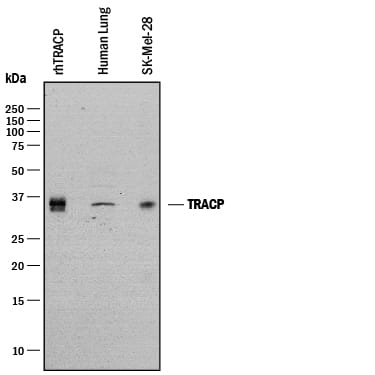Human TRACP/PAP/ACP5 Antibody
R&D Systems, part of Bio-Techne | Catalog # AF3948


Key Product Details
Species Reactivity
Applications
Label
Antibody Source
Product Specifications
Immunogen
Ala22-Pro320
Accession # P13686
Specificity
Clonality
Host
Isotype
Scientific Data Images for Human TRACP/PAP/ACP5 Antibody
Detection of Human TRACP/PAP/ACP5 by Western Blot.
Western blot shows lysates of human lung tissue, SK-Mel-28 human malignant melanoma cell line and Recombinant Human TRACP/PAP/ACP5 (Catalog # 3948-AP). PVDF membrane was probed with 0.5 µg/mL of Sheep Anti-Human TRACP/PAP/ACP5 Antigen Affinity-purified Polyclonal Antibody (Catalog # AF3948) followed by HRP-conjugated Anti-Sheep IgG Secondary Antibody (Catalog # HAF016). A specific band was detected for TRACP/PAP/ACP5 at approximately 36 kDa (as indicated). This experiment was conducted under reducing conditions and using Immunoblot Buffer Group 1.Applications for Human TRACP/PAP/ACP5 Antibody
Immunoprecipitation
Sample: Conditioned cell culture medium spiked with Recombinant Human TRACP/PAP/ACP5 (Catalog # 3948-AP), see our available Western blot detection antibodies
Western Blot
Sample: Human lung tissue, SK‑Mel‑28 human malignant melanoma cell line and Recombinant Human TRACP/PAP/ACP5 (Catalog # 3948-AP).
Formulation, Preparation, and Storage
Purification
Reconstitution
Formulation
Shipping
Stability & Storage
- 12 months from date of receipt, -20 to -70 °C as supplied.
- 1 month, 2 to 8 °C under sterile conditions after reconstitution.
- 6 months, -20 to -70 °C under sterile conditions after reconstitution.
Background: TRACP/PAP/ACP5
Encoded by the ACP5 gene, Tartrate Resistant Acid Phosphatase (TRACP or TRAP) is also known as Purple Acid Phosphatase (PAP) or Acid Phosphatase 5 (ACP5) (1). The deuced amino acid (aa) sequence of human ACP5 predicts a signal peptide (aa 1 to 21) and a mature chain (aa 22 to 325). R&D Systems' recombinant human ACP5 consists of aa 22 to 320, without the last 5 residues, RRARP.
ACP5 is expressed at high levels by osteoclasts, macrophages and dendritic cells (2). Two forms, 5a and 5b, circulating in human blood, are derived from different cell types and have different functions. Derived from macrophages and dendritic cells, 5a is a marker of inflammatory conditions. Derived from osteoclasts, 5b is a marker of bone resorption. Compared to 5a, 5b does not contain sialic acid residues, has a higher specific activity and pH optimum, and may be processed into a disulfide-linked dimer (3).
References
- Janckila, A.J. and J.M. Halleen (2003) J. Bone Miner. Res. 18:1892.
- Halleen, J.M. et al. (2006) Clin. Lab. 52:499.
- Janckila, A.J. et al. (2003) J. Bone Miner. Res. 18:1916.
Long Name
Alternate Names
Gene Symbol
UniProt
Additional TRACP/PAP/ACP5 Products
Product Documents for Human TRACP/PAP/ACP5 Antibody
Product Specific Notices for Human TRACP/PAP/ACP5 Antibody
For research use only